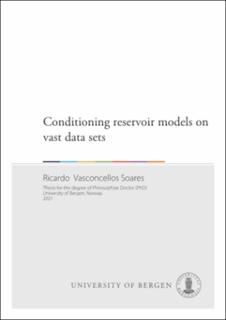| dc.contributor.author | Soares, Ricardo Vasconcellos | |
| dc.date.accessioned | 2021-08-17T10:46:34Z | |
| dc.date.available | 2021-08-17T10:46:34Z | |
| dc.date.issued | 2021-09-09 | |
| dc.date.submitted | 2021-07-09T12:25:33.000Z | |
| dc.identifier | container/38/45/d8/d1/3845d8d1-8c3c-4e76-9d28-38de57e0c402 | |
| dc.identifier.isbn | 9788230855102 | |
| dc.identifier.isbn | 9788230860595 | |
| dc.identifier.uri | https://hdl.handle.net/11250/2768790 | |
| dc.description.abstract | History matching is a valuable process to obtain better models and a more reliable forecast in oil reservoir applications. In such processes, one conditions the simulation models on the observed data from the field. One can formulate history matching as an inverse problem, where one has the final answer (i.e., the observed data from the field) and wants to update the model parameters that lead to this answer. There are different methods to perform this update, and among them, ensemble-based methods are state-of-the-art.
Many different research fields use ensemble-based methods, such as oil reservoirs, oceanography, and meteorology. They can represent the models' uncertainties and solve the history matching problem through an ensemble of models. Iterative ensemble-based methods have been more commonly used in oil reservoir applications because of the problem's strong nonlinearity.
The development of new sensors and new technologies have enabled conditioning models on distinct data types. Moreover, the increase in computational power has allowed dealing with larger data sets. Nevertheless, the use of these vast data sets still faces some problems. Depending on how one implements the ensemble methods, they can generate enormous matrices that are impractical to handle and manipulate.
Furthermore, ensemble-based methods might underestimate the variability after history matching because of a limited ensemble size and simplifications in the measurement errors. Therefore, one could use a localization technique to compensate for this problem. However, depending on the type of data used to condition the models, localization can be challenging.
One common data set that has gained much importance lately is the 4D seismic. On the one hand, such a data set brings information about pressure and saturation changes throughout the reservoir. On the other hand, 4D data sets can be immense and incur additional issues to the history-matching process. This thesis focuses on conditioning oil-reservoir models on such vast data sets.
Firstly, we investigate a Dictionary Learning method, the K-SVD, to represent the 4D seismic data set sparsely. In this part, we focus on reducing the data-set size without losing its main information. Besides, we also investigate a way of optimizing the computational cost of the data reduction algorithm.
Secondly, we use the sparsely represented data in an ensemble-based history matching process. In this work, we develop a new implementation of the Iterative
Ensemble Smoother Regularized Levenberg--Marquardt. We also compare two ways of dealing with the vast size of the 4D seismic, one with the 4D seismic after applying the K-SVD algorithm and one with the complete data set projected into the ensemble subspace. Using Amplitude versus Angle as the seismic data and a benchmark case, the results show the importance and improvement obtained when using the sparse data.
Furthermore, we also investigate a correlation-based local analysis scheme which allows us to introduce more information from the measurement into the model and avoid variability underestimation. An advantage of local analysis is the ability to partition the models and data sets and update the model using smaller parts, which is suitable for large models and data sets. We also discuss local analysis in a 4D-seismic history matching using a different ensemble method, the Subspace Ensemble Randomized Maximum Likelihood.
Finally, Dictionary Learning's use to sparsely represent a vast data set, and the correlation-based local analysis scheme helps to deal with the big size of the observed data and generate a good representation of the reservoir. | en_US |
| dc.language.iso | eng | en_US |
| dc.publisher | The University of Bergen | en_US |
| dc.relation.haspart | Paper A: Soares, R.V., Luo, X., Evensen, G., Sparse Representation of 4D Seismic Signal Bassed on Dictionary Learning, in SPE Norway One Day Seminar, 2019. SPE- 495599-MS. The article is not available in BORA due to publisher restrictions. The published version is available at: <a href="https://doi.org/10.2118/195599-MS" target="blank">https://doi.org/10.2118/195599-MS</a> | en_US |
| dc.relation.haspart | Paper B: Soares, R.V., Luo, X., Evensen, G., Bhakta, T., 4D Seismic History Matching: Assessing the use of a Dictionary Learning Based Sparse Representation Method, Journal of Petroleum Science and Engineering. 195 (2020), 107763. The article is available at: <a href="https://hdl.handle.net/11250/2727220" target="blank">https://hdl.handle.net/11250/2727220</a> | en_US |
| dc.relation.haspart | Paper C: Soares, R.V., Luo, X., Evensen, G., Bhakta, T., Handling Big Models and Big Data Sets in History Matching Through Local Analysis, SPE Journal (2020). SPE- 204221-PA. The article is not available in BORA due to publisher restrictions. The published version is available at: <a href="https://doi.org/10.2118/204221-PA" target="blank">https://doi.org/10.2118/204221-PA</a> | en_US |
| dc.relation.haspart | Paper D: Neto, G.M.S., Soares, R.V., Evensen, G., Davolio, A., Schiozer, D.J., Subspace Ensemble Randomized Maximum Likelihood with Local Analysis for Time-Lapse- Seismic-Data Assimilation, SPE Journal (2021). SPE-205029-PA. The article is not available in BORA due to publisher restrictions. The published version is available at: <a href="https://doi.org/10.2118/205029-PA" target="blank">https://doi.org/10.2118/205029-PA</a> | en_US |
| dc.rights | In copyright | |
| dc.rights.uri | http://rightsstatements.org/page/InC/1.0/ | |
| dc.title | Conditioning reservoir models on vast data sets | en_US |
| dc.type | Doctoral thesis | en_US |
| dc.date.updated | 2021-07-09T12:25:33.000Z | |
| dc.rights.holder | Copyright the Author. All rights reserved | en_US |
| dc.description.degree | Doktorgradsavhandling | |
| fs.unitcode | 12-11-0 | |
